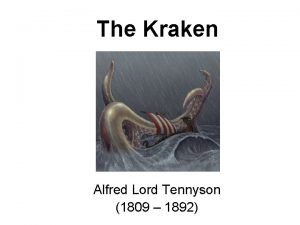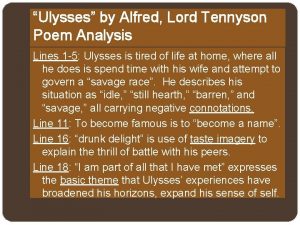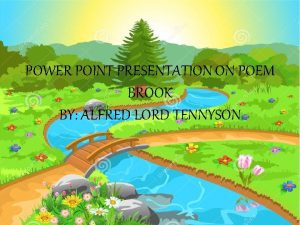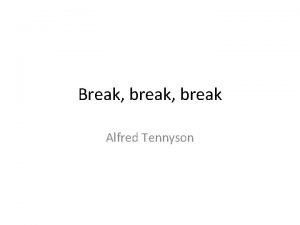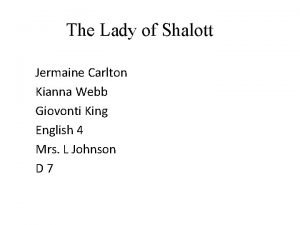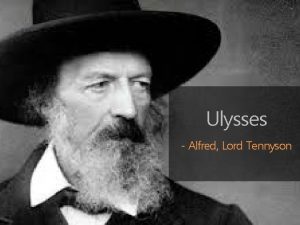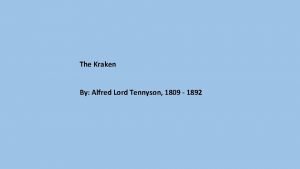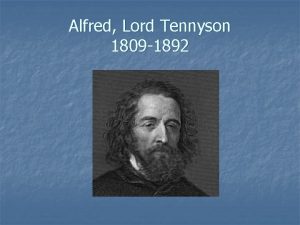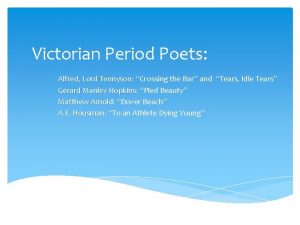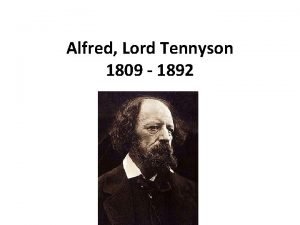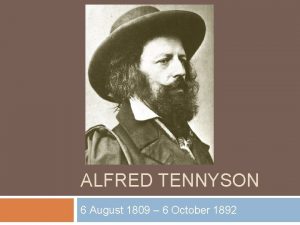Poets Tennyson and Eliot Alfred Tennyson 1809 1892







- Slides: 7

Poets Tennyson and Eliot

Alfred Tennyson (1809 – 1892) Alfred Tennyson’s poetry developed at Cambridge through contact with the Apostles, a group of writers guided by Arthur Hallam. Sensations He combined Romantic motifs with a classical atmosphere Rendering the impact of the physical world of the senses His sudden death traumatized Tennyson who wrote In Memoriam, a series of lyrics that brought him national fame. Tennyson’s Poetry Tennyson gives voice to love for adventures and a passionate idea of life Pessimism Main themes: regret and loss His subjects are often taken from the past (as the Homeric Ulysses), revived through immagination: dreaming is an escape

Dramatic Monologue: Monologue • • poem set in a precise historical and geographical background; recited by a first-person speaker who tells about crucial moment of his own life; there is a silent listener; the character’s moral the language is colloquial. faults emerge from the situation The best use of this form was by the Victorian poet Robert Browning. In My Last Duchess the ‘actor’ of the monologue is an imaginary Duke from the Italian Renaissance who tells about his late wife, whose murder was ordered by the Duke himself because her good manners to everybody seemed to him an insult to his rank. Browning social used unconventional language and he believed that personality is a multiplicity of. He selves exerted a great influence on early 20 th-century modernist poetry.

Tennyson’s Ulysses (1842) In this dramatic monologue Ulysses cannot accept the Like Homer’s Ulysses, he is a restless monotonous life at Ithaca: spirit, ever open to new experience; he finds the meaning of life in continuous movement to pass the unknown «And this gray spirit yearning in desire To follow knowledge like a sinking star, Beyond the utmost bound of human thought» «For always roaming with a hungry Like Dante’s Ulysses, endless searching becomes a dangerous hearth. » «I will drink desire forbidden experience Life to the lees. » «One equal temper of heroic hearts, The poem can be read as Tennyson’s Made weak by time and fate, but opposition to Victorian decorum Ø G. Bargellini, Ulisse strong in will To strive, to seek, to find, and not to yield. »

Thomas Stearns Eliot (1888 -1965) • He was born in the United States but lived in Europe. • The American poet Ezra Pound exerted an enourmous literary influence on him. • During the 30 s he found a way out of nihilism toward Christian faith. • After World War II Eliot was occupied with drama, criticism and reviewing. The I phase of Eliot’s career was influenced by NIHILISM: • In 1948 he received Nobel prize in literature. It expresses the modern artist’s The Waste Land disillusion with the world. the (1922) most important Modernist poem; § § divided in five sections characterized by: • • • «The Burial of the Dead» «A Game of Chess» «The Fire Sermon» «Death by Water» «What the Thunder Said» • • The poets see only ruin and desolation around them. He was interested in Fragmentation of structure; aspects of the decay Use of images, echoes and quotations from of western civilization religious and philosophical tradition; after WWI. Complex language with use of stream of consciousness technique; method; Mythical • Metrical pattern: lines vary in length and rhythm, so there are both free and regular verses.

The Burial of the Dead The framework for the whole poem is given by references to sterility and fertility. These images are inspired by the relations between ancient fertility myths and rituals of early christianity and by the medieval romances of the Holy Graal «The Burial of the Dead» is the first section and contains the main themes. The spring is seen as a “cruel season” that breaks the illusion of safety and protection created by the winter. The contrast aridity/fertility is established with images which describe a fragmented and sterile world. « April is the cruellest month, «Son of man, breeding You cannot say, or guess, for you know only Lilacs out of the dead land, A heap of broken images, where the sun beats, mixing And the dead tree gives no shelter, the cricket no r Memory and desire, stirring And the dry stone no sound of water. » Dull roots with spring rain. Winter kept us warm, covering They are modelled on damned Earth in forgetful snow, feeding At the stroke of nine a procession of employees souls of Dante’s Inferno. A little life with driedidentity, tubers. » dragging along the London without « Unreal city, Bridge towards the heart of productivity: Under the brown fog of a winter dawn, a river of undead who evokes A crowd flowed over London Bridge, so ma gloomy images of death. I had not thought death had undone so man Sighs, short and infrequent, were exhaled, Ø E. Munch, Evening on Karl Johan Street And each man fixed his eyes before his fee

Power point created by: Chiarenza Concetto, Consolo Valeria, Di Mauro Laura, Magrì Enrico, La China Janice Classe QUINTA sez. B A. S. 2016 – 2017 Sources: A. Cattaneo – D. De Flavis, Millenium, Signorelli

